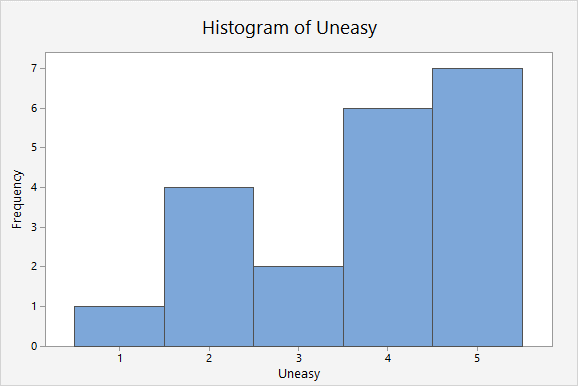This discussion allowed one to have an excellent opportunity to try Minitab’s tool for data analysis using the example of a simple data set. Descriptive statistics help nurses identify the properties of the data set. According to Heavy (2019), the main methods of this statistical analysis are central tendency and the spread of variables from the central value. For example, the mean of the participant’s age is 36 years old, while the median age is 33.5. Hence, the researcher may conclude that the majority of participants are around the age of 36, which can be later used to draw conclusions based on their responses, despite the fact that some respondents are younger and some are older. For the “cringe” variable, the mean is 3.2, and the median is 3.5. Next, the “uneasy” variable has a mean of 3.7 and a median of 4, which shows that more participants feel uneasy as opposed to “cringe.” For the variable “afraid,” both the mean and the median are 3.5. The mean for “worried” is 2.5, while the median is 2.6. From examining this value, one can see that being “worried” is a much lesser concern for the participants as opposed to others. Finally, the responses for the “understand” variable have a mean and median of 3.
This basic statistical analysis of the data helps understand some of the core properties of this data set. The mean value in this data set shows the average value of the response, while the median is the middle value within the response if they are arranged in sequence (Heavy, 2019). With this approach, the researcher can determine which of the variables is of more concern to the participants by looking at the highest mean value.
The histogram displayed in Figure 1 represents the variability of the data in this data set. The purpose of this statistical tool is to give a researcher a visual representation of data for analysis and see the number of data points that correspond to a specific range of values (Heavy, 2019). Specifically, it shows the relationship between the participant’s age and the factors reviewed in the survey, which is “cringe, uneasy, afraid, worried, and understand” feelings. Histograms are a helpful visual tool since they allow one to analyze the data by looking at the graph quickly. For example, when creating a histogram for each variable in this data set, one can see that as people age, they feel more uneasy but less worried. Figure 1 is a histogram created based on the variables “age” and “uneasy.” Based on it, one can assume that people between the ages of 40 and 60 report the highest levels of the “uneasy” feeling, which allows drawing some hypotheses as to the reasons and age-specific factors. Notably, people below the age of 30 report having this feeling less often than those of other ages.
In summary, working with Minitab’s tools for statistical analysis makes the process of data analysis easier because this software is designed for the purpose of statistical analysis and has built-in tools for it. With this data set, the descriptive statistics allowed us to determine basic characteristics of data. Both descriptive statistics and a histogram can help perform a basic analysis of data and evaluate its basic properties.

The created histogram shows how frequently the respondents choose each option (ranging from 1 to 5) when answering the “uneasy” question. In particular, the most common indicator 5 was selected seven times, and option 4 was chosen six times. Then, reducing the frequency, option 2 was elected four times, 3 – two times, and finally, 1 – only once. Such ranking demonstrates respondents’ confidence in their answers – they are not focused on the average position. The total response frequency of high scores (4 and 5) is thirteen, as opposed to the sum of the frequency of 1, 2, and 3 – only seven times in total. This fact means that the responders’ majority’s answers are leaning towards high frequency, demonstrating mainly the consistency and common opinion of interviewees with respect to the discussed indicator.
Reference
Heavy, E. (2019). Statistics for nursing: A practical approach (3rd ed.). Jones & Bartlett.